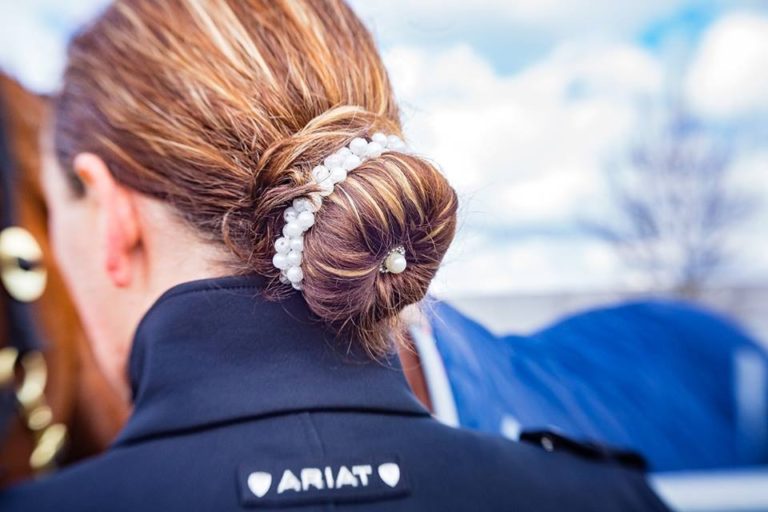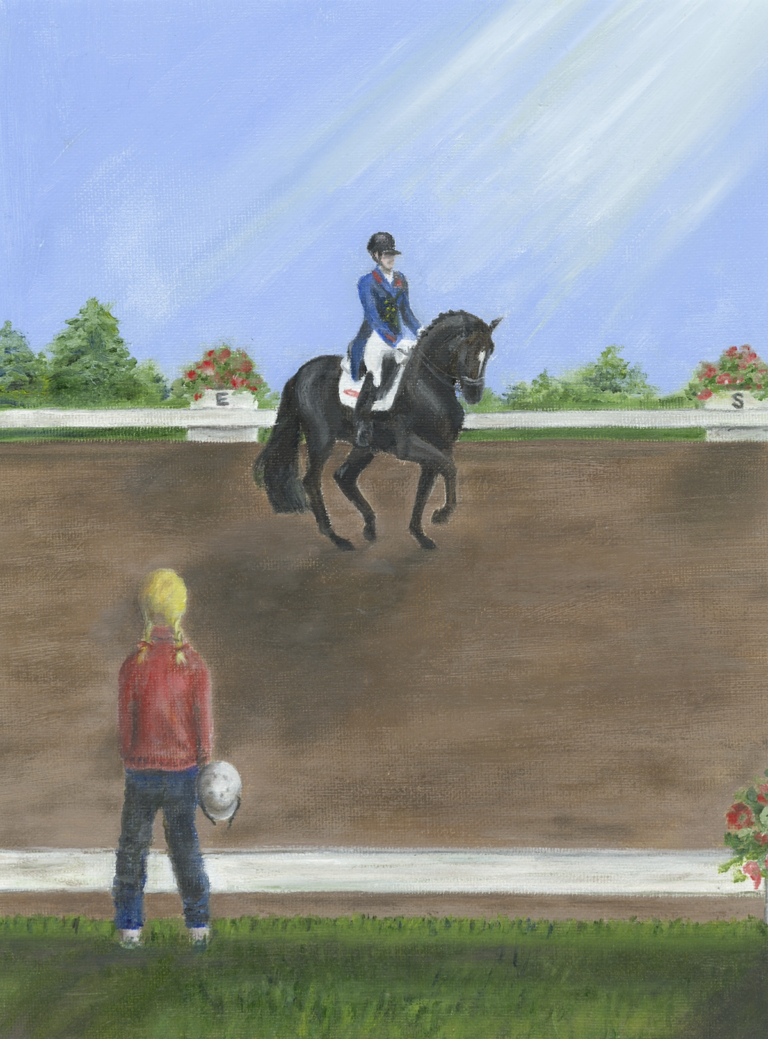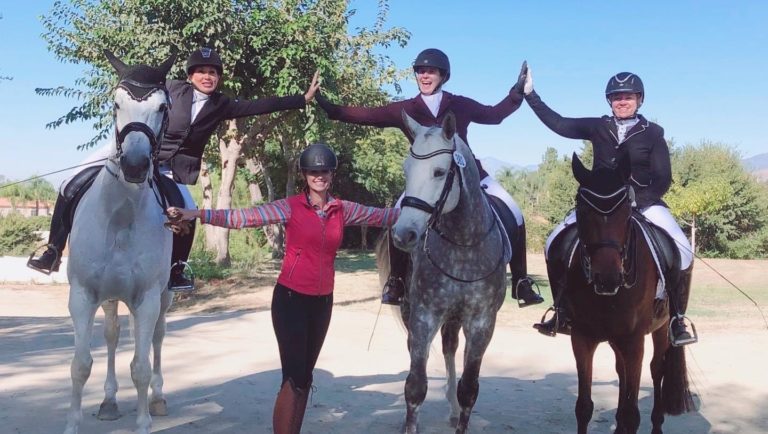Stability before mobility’ can be a handy way to remember the order of training priorities for riders, especially those suffering from any back pain. Actually, creating straightness and protecting the spine is important for anyone. In work I do teaching on spine stability, we always start with techniques for stabilizing the spine prior to any work that introduces motion or loading. Participants in the course are usually sent by their physiotherapist due to back issues, and participants range from relatively sedentary lifestyles, to marathon athletes.
Sometimes the more athletic participants are at greatest risk because they challenge their bodies more.
A common trait among the athletes is that their bodies are so good at finding ways to meet demand that they have developed very interesting compensating patterns. The patterns eventually work against them. The more athletic and successful the person is, the longer they tend to go without addressing the negative pattern, because they don’t need to. Finally an injury or chronic pain stops them, and then they have to work hard to re-train muscle patterns for healthier movement which will allow them to continue to be an active sport participant for future decades.
The more sedentary or less active participants have also developed negative patterns, and usually experience or are more at risk for acute injury than the athletes. On one hand, they do not have the strain issues of the athletes because they just aren’t doing enough to create such issues. On the other, being blissfully out of shape is no help either since they are at higher risk for illnesses and complaints related to sedentary lifestyle choices, and for acute injury.
Since riders are first humans, it is no surprise that I observe the same tendencies among riders as I do other athletes and clients. With age, the leisure rider loses muscle tone, range of motion and ability for speedy response. Combined with less frequent riding, this rider is more at risk for a sudden injury from an incident such as a spook, or a particularly tough riding day. While the more full time athlete or professional has more skill and does not have the same risks as the amateur or leisure rider, eventually compensating patterns catch up and I see seemingly unconnected larger issues such as need for hip replacement, deep tissue therapy, frozen shoulders, and the often laughed-off complaint that ?I can’t walk (or insert other activity), but I can still ride’.
In the spine stability group, the problems are occurring in the participant’s backs, and so the course is about re-teaching participants to properly stabilize their spine using more effective muscle firing patterns for core activation. When stabilization can become more automatic, they can shift to movement and increased loading or effort while maintaining the stability in their spine. This helps them shift back to the sport or activity they need to do, but this time with a much stronger and more engaged core so that they can reduce the possibility of injury and even increase performance or enjoyment of life because they are moving the way they were designed to.
Given the heavy time investment required of all riders, whether riding occasionally for leisure or more full time, the good news is that the rider can make significant improvements in joint and posture supporting strength with very little equipment and relatively little time as long as one is diligent. When you think about it, you may only ask one horse to do serious work for at most half an hour out of his entire day. The rest of his workout is warmup, cooldown, and lengthen/stretch/relaxation between exercises. So, except for riders in disciplines requiring extreme levels of stamina, most riders can improve their performance and reduce their risk of injury and pain (acute or long-term) with fairly minimal additional effort.
Clearly frequency is important. One session a week would be insufficient. The horse that you expect to progress, needs to be working 5-6 days a week. Similarly, someone in re-habilitation has exercises that must be done daily. As the workload increases, the frequency in the week drops a bit, and harder days are alternated with lighter ones. When the goal is reached, maintenance is quite easy with a few times of exercises per week and generally more active lifestyle. So, a rider that wishes to make significant improvements in things like core strength, posture or supportive strength around problem joints can expect to start with very short daily exercises, and gradually reduce the frequency as the output increases.
Five minutes a day of postural or core work can become 30 minutes, 2-3x a week in several months. The key is diligence. For riders in particular, posture and technique are more important than the output (number of repetitions or resistance/weights used if any). Never sacrifice correct execution for volume or speed.
Also, try not to overthink. A goal is to be able to train automatic correctness so that you can rely on correct muscle engagement for torso support while riding without thinking about it. Participants in other sports train their throw, swing, race start, kick (name any movement), but at a certain point they have to reach the point of automating the elements so they can actually perform in the sport. Constantly overthinking movements in your unmounted exercises (or on the horse) blocks you, and is not the goal. (The sometimes unfortunate irony is that the rider who pays attention to these details and is interesting in using groundwork in their training plan, is often the same person who has a tendency to overthink their work both on and off the horse.) A rider using groundwork exercises such as those described in these articles, is using the ground time to slow movement and engagement down to train better movement and stamina, so that when they are in the saddle they can focus on the riding and not which muscle is doing what, and especially not on exerting force consciously.
In the last two pieces in this mini-series on the rider’s back, we looked at some of the significant muscle groups involved in a rider’s posture, as well as an exercise for building strength along the postural support line from a rider’s seat to their upper back using an exercise that promotes correct firing sequence and complete engagement along the chain (the bent over forward reach). The exercise from the previous article (http://blogs.equisearch.com/equestrian-fitness-with-heather-sansom/?p=34) is a good starting point because it takes a rider completely out of positions used in riding. The rider can concentrate on the execution of the exercise and is less at risk for automatically falling into compensating patterns. As the movement becomes more automatic and there is visible improvement in muscle tone and stamina, it’s time to introduce additional challenges that will help transfer to riding.
Challenge #1: Transfer the movement back to a vertical plan with lateral asymmetry.
Moving to an upright posture from a horizontal one can be a challenge for some people. All call these transfers from one plane to another ?brain gym’ for neuro-muscular connection. The goal is to use the exact same firing sequence as was used for the bent over reach. The feeling of doing the exercise should be the same except that the rider is vertical and the removal of gravity for loading (weight of the rider’s arm) necessitates loading by other means (resistance tubing works well). The rider also has to actively neutralize the spine by tucking the tailbone under and consciously engaging core strength to do so in order to resist all tendency for the back to hollow or shoulders to be thrown back during the exercise. It is best to ensure correct form and motion with no resistance before introducing resistance. If tension is felt in the shoulder/neck area, remove resistance and persist until the movement can be made with only softness in the shoulders. Most riders I give this exercise to have been compensating with upper trapezius (tight neck/shoulders) and their first tendency when back in a vertical plane is to shrug the shoulders and try and use upper body strength, rather than stabilize their spine through a solid base around the middle with the arm only an incidental extension of their body. It can take a week or two before introducing resistance.
The horse’s back is never symmetrical in motion under the rider, so putting your legs in a split lunge to do the exercise helps replicate the situation with riding where a rider can be tempted to collapse one side of their hip. Maintaining horizontal straightness in the hips, in spite of asymmetrical leg position forces a rider to properly engage torso stabilizers that control lateral and rotational support.
The exercise: overhead raise in split lunge. Step into the lunge, stabilize or neutralize the spine with good core engagement, and raise the arm straight overhead without throwing shoulders back or hollowing the lower back. The ear, shoulder and hip socket should be aligned as required for riding. A rider with bound shoulders will have trouble raising their arms straight overhead and may need to spend a few weeks opening the shoulders with stretches and other mobilizing exercises first.
Challenge #2: Overhead raise seated on a ball. Return to seated position, minus old compensating patterns. In this variation , the rider maintains the vertical posture, but is seated on an exercise ball. The challenge will be to resist whatever collapsing pattern previously used, and maintain the same engagement discovered through the other exercises. Use of mirrors or a training partner is important for these exercises so that you can have an accurate observation of alignment. A rider correcting a faulty pattern typically has an offset internal sense of straightness, which needs to be re-set as the rider achieves more correct straightness.











